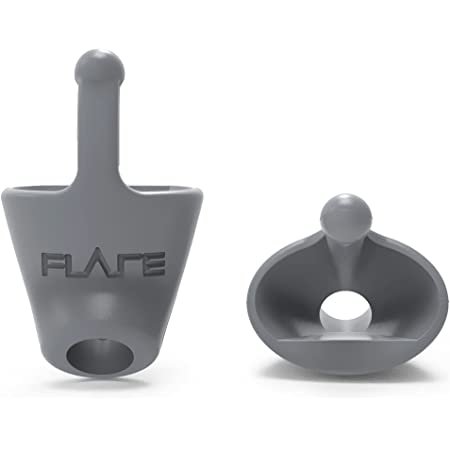These Are The Best Earbuds for Sound Sensitivity
Looking for earbuds to help turn the noise sensitivity dial down? These special earbuds help make life less overwhelming.
By Jacqueline Raposo for Reviewed
Read on Reviewed.
Click here to download a PDF of the story for your reader.
If you click on purchase links in this story, I get Amazon affiliate credit.
When you're sensitive to sound, noise-canceling headphones aren’t always the best fix. Sure, they muffle the crush of public transportation or the clatter of a busy social event. But they require device interaction, they can weigh heavily on our bodies, and blocking out all noise isn’t the solution to the constant, scattered sounds that hurt.
My sound sensitivities are caused by the post-viral illness Myalgic Encephalomyelitis (ME/CFS). It means that the constant mechanical buzzes, beeps, and hums of our modern world scrape through my brain and down my spine. A moderately loud dog bark sends my pulse racing, and the steady rumble of a traffic jam wipes me out as if I’d run the highway home, not driven it.
Those with long COVID-19, autism, and various chronic invisible illnesses often share such sound sensitives. Disability aids for this population usually include foam or electric earbuds or headphones designed to turn the volume of all sounds down or off. But removing sound entirely also separates us from the non-disabled world. We want to hear a conversation, music, birdsong, and many other lovely sounds. We just don’t want car motors and microwave beeps to jump us into fight-or-flight mode.
This makes Flare Audio's Calmer earbuds a welcome contribution to the disability space.
How do Calmer ear buds work?
Calmer earbuds dull harsh noise, from loud city sounds to nearby conversations.
Flare Audio’s Calmer are tiny single-piece hearing devices that sit gently inside the ear. They’re unwired and don’t connect to an app or device. And unlike foam or wax earplugs, they’re hollow inside. Rather than muffle or remove volume entirely, the earbuds create a tiny waveguide within the shell shape of our ear that smooths out only mid-frequency sounds—those between 2 kHz and 8 kHz. They’re the car engines, machine hums, slamming doors, and piercing dog barks that progressively exhaust.
By concentrating and smoothing out those sounds, the fight-or-flight response fades. Other sounds remain clear. The brain has less work to do in filtering and adjusting as it moves through the world. We feel calmer as a result.
What I like
They’re subtle
I immediately went for a drive after first popping them in. I soon noticed that I could keep the car’s windows down: the sound of a truck passing usually floods and befuddles my brain, but now felt like a harmless rumble. Sounds like dehumidifiers, fans, and a lawnmower next door became less noticeable. When I regularly wear the Calmer buds, I can focus on work for extended periods of time. I’m less distracted by sound. And less depleted energetically as a result.
They’re proven to work
After scanning a stream of robustly positive comments on Facebook from the autistic community, I became curious about how Calmer earbuds might work for me. Countless further client case studies illustrate how they’ve actively made a difference in the lives of those sensitive hearing disorders, too. But I feel most confident in that official consultancy reports confirm their efficacy; you can learn via various reports on their website how sound waves hit the ear with and without the buds.
They’re comfortable
The soft feel of silicon makes long lasting use painless.
Calmer earbuds are so lightweight that I couldn’t get my kitchen scale to register them at even a gram. And they’re made of a soft-touch silicone, which molds easily to fit the shape of the ear and has proved extremely durable. This means—unlike headphones or wired earbuds—I wear them through the day and barely register that they’re in.
They’re affordable
Calmer earbuds are about $30 a pair, making them far more affordable than many audio aids or quality noise-canceling headphones. They come in four colors: purple, mint, grey, and translucent. And they offer two sizes: standard and mini.
What I don’t like
The fit isn’t 100% secure
There are downsides to their being so subtle: If I take off a mask or sunglasses and knock one out, I might not register it’s gone. I prefer the translucent option of the four because it makes them nearly invisible. But that also makes them hard to find if I drop them in a parking lot.
After losing the standard size in my left ear (twice), I got a pair of minis. These fit even more securely. But I’m not sure I get the best effect with them, comparatively, so I use them most often in situations where I might lose the standard size. I wish there were more sizing options to fit that problem. And because they ship from the UK, it takes a few weeks for a replacement pair to come in.
Should you buy them?
If noise is sometimes a problem for you, absolutely.
Calmer earbuds are a great investment for those who struggle with noise.
Thousands of reviews show Calmer earbuds work wonders for many people with varying illnesses and sound disorders. A relatively new Calmer Pro version (at $70 a set) boasts an aluminum reflector within the silicone shell, revealing even more details in harmless sound. But as I live a relatively quiet life, I haven’t shelled out for them. If you’re more readily introduced to busy or overwhelming environments, you might want to check them out.
If looking to reduce the volume of all sound, Vibes reusable earbuds run for $26.95. If I were to get more techy, I might try Nuheara’s IQbuds MAX. They’re a hefty $500 and more for those with hearing loss than sound sensitivities. But they offer customizable noise cancellation and reduction monitored via an accompanying app.



